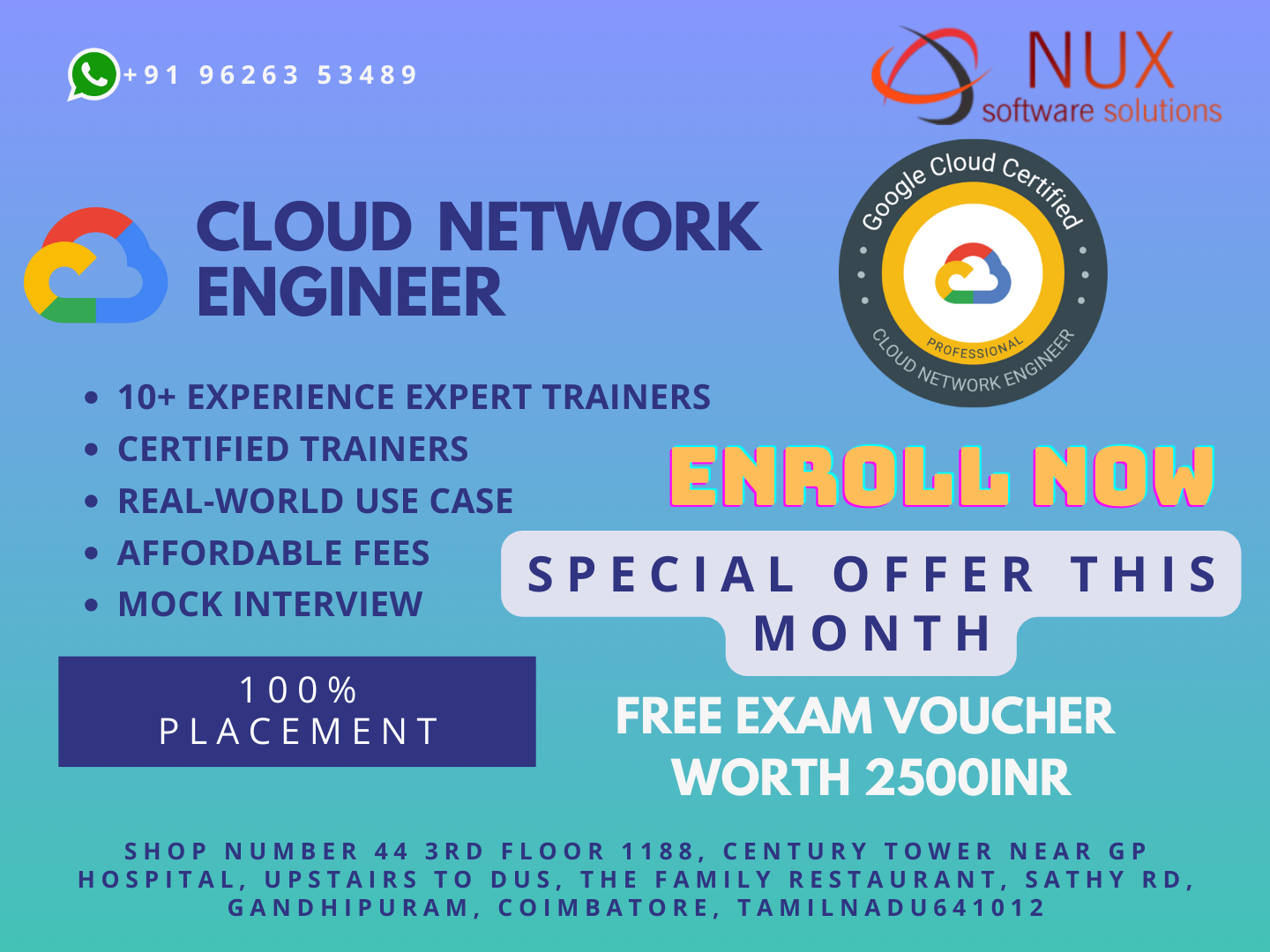Cloud Network Engineer


Best cloud Network Engineer training courses classes deliver by Nux software solutions in coimbatore. Nux software solutions in coimbatore has excellent and advanced training programs that will give you better performance & hands on experience. Our industry’s expert trainers offer a wide range of skills and experience in their graded areas.
The Training center environment is too good for professional, individual, corporate, live project training and industrial training. Labs infrastructure is advanced, well managed and you can access LAB 24X7 from anywhere. Training center has international expert trainers and they have excellent knowledge, real time industry experience.
Our Training programs combine with several innovative learning methods and delivery models. We understand your requirement and it will give you 100 percent growth for your career and provide the cost effective training programs and also work with flexibility for the trainees.
The Google Cloud Network engineer certification was ranked one of the top paying IT certifications of Global Knowledge.
This program provides the skills you need to advance your career as a professional cloud architect and recommends training to support your preparation for the industry-recognized Google Cloud Professional Cloud Architect certification.
You’ll have the opportunity to deploy solution elements, including infrastructure components such as networks, systems and applications services, and you’ll gain real world experience through a number of hands-on Qwiklabs projects.
Upon successful completion of this program, you will earn a certificate of completion to share with your professional network and potential employers.
If you would like to become Google Cloud certified and demonstrate your proficiency in the understanding of cloud architecture and Google Cloud Platform, design, develop, and manage solutions to drive business objectives, you will need to register for, and pass the official Google Cloud certification exam. You can find more details on how to register and additional resources to support your preparation at Nux software solutions.
Course Syllabus
Module
Chapter 1.
1.0 Designing, planning, and prototyping a GCP network
1.1 Designing the overall network architecture. Considerations include:
Failover and disaster recovery strategy, Options for high availability, DNS strategy (e.g., on-premises, Cloud DNS, GSLB), Meeting business requirements, Choosing the appropriate load balancing options, Optimizing for latency (e.g., MTU size, caches, CDN), Understanding how quotas are applied per project and per VPC, Hybrid connectivity (e.g., Google private access for hybrid connectivity), Container networking, IAM and security, SaaS, PaaS, and IaaS services, Microsegmentation for security purposes (e.g., using metadata, tags)
1.2 Designing a Virtual Private Cloud (VPC). Considerations include:
CIDR range for subnets, IP addressing (e.g., static, ephemeral, private), Standalone or shared, Multiple vs. single, Multi-zone and multi-region, Peering, Firewall (e.g., service account-based, tag-based), Routes, Differences between Google Cloud Networking and other cloud platforms
1.3 Designing a hybrid network. Considerations include:
Using interconnect (e.g., dedicated vs. partner), Peering options (e.g., direct vs. carrier), IPsec VPN, Cloud Router, Failover and disaster recovery strategy (e.g., building high availability with BGP using cloud router), Shared vs. standalone VPC interconnect access, Cross-organizational access, Bandwidth
1.4 Designing a container IP addressing plan for Google Kubernetes Engine
Chapter 2.
2.0 Implementing a GCP Virtual Private Cloud (VPC)
2.1 Configuring VPCs. Considerations include:
Configuring GCP VPC resources (CIDR range, subnets, firewall rules, etc.), Configuring VPC peering, Creating a shared VPC and explaining how to share subnets with other projects, Configuring API access (private, public, NAT GW, proxy), Configuring VPC flow logs
2.2 Configuring routing. Tasks include:
Configuring internal static/dynamic routing, Configuring routing policies using tags and priority, Configuring NAT (e.g., Cloud NAT, instance-based NAT)
2.3 Configuring and maintaining Google Kubernetes Engine clusters. Considerations include:
VPC-native clusters using alias IPs, Clusters with shared VPC, Private clusters, Cluster network policy, Adding authorized networks for cluster master access
2.4 Configuring and managing firewall rules. Considerations include:
Target network tags and service accounts, Priority, Network protocols, Ingress and egress rules, Firewall logs
Chapter3.
3.0 Configuring network services
3.1 Configuring load balancing. Considerations include:
Creating backend services, Firewall and security rules, HTTP(S) load balancer: including changing URL maps, backend groups, health checks, CDN, and SSL certs, TCP and SSL proxy load balancers, Network load balancer, Internal load balancer, Session affinity, Capacity scaling
3.2 Configuring Cloud CDN. Considerations include:
Enabling and disabling Cloud CDN, Using cache keys, Cache invalidation, Signed URLs
3.3 Configuring and maintaining Cloud DNS. Considerations include:
Managing zones and records, Migrating to Cloud DNS, DNS Security (DNSSEC), Global serving with Anycast, Cloud DNS, Internal DNS, Integrating on-premises DNS with GCP
3.4 Enabling other network services. Considerations include:
Health checks for your instance groups, Canary (A/B) releases, Distributing backend instances using regional managed instance groups, Enabling private API access
Chapter 4.
4.0 Implementing hybrid interconnectivity
4.1 Configuring interconnect. Considerations include:
Partner (e.g., layer 2 vs. layer 3 connectivity), Virtualizing using VLAN attachments, Bulk storage uploads
4.2 Configuring a site-to-site IPsec VPN (e.g., route-based, policy-based, dynamic or static routing).
4.3 Configuring Cloud Router for reliability.
Chapter 5.
5.0 Implementing network security
5.1 Configuring identity and access management (IAM). Tasks include:
Viewing account IAM assignments, Assigning IAM roles to accounts or Google Groups, Defining custom IAM roles, Using pre-defined IAM roles (e.g., network admin, network viewer, network user)
5.2 Configuring Cloud Armor policies. Considerations include:
IP-based access control
5.3 Configuring third-party device insertion into VPC using multi-nic (NGFW)
5.4 Managing keys for SSH access
Chapter6.
6.0 Managing and monitoring network operations
6.1 Logging and monitoring with Stackdriver or GCP Console
6.2 Managing and maintaining security. Considerations include:
Firewalls (e.g., cloud-based, private), Diagnosing and resolving IAM issues (shared VPC, security/network admin)
6.3 Maintaining and troubleshooting connectivity issues. Considerations include:
Identifying traffic flow topology (e.g., load balancers, SSL offload, network endpoint groups), Draining and redirecting traffic flows, Cross-connect handoff for interconnect, Monitoring ingress and egress traffic using flow logs, Monitoring firewall logs, Managing and troubleshooting VPNs, Troubleshooting Cloud Router BGP peering issues
6.4 Monitoring, maintaining, and troubleshooting latency and traffic flow. Considerations include:
Network throughput and latency testing, Routing issues, Tracing traffic flow
Chapter 7.
7.0 Optimizing network resources
7.1 Optimizing traffic flow. Considerations include:
Load balancer and CDN location, Global vs. regional dynamic routing, Expanding subnet CIDR ranges in service, Accommodating workload increases (e.g., autoscaling vs. manual scaling)
7.2 Optimizing for cost and efficiency. Considerations include:
Cost optimization (Network Service Tiers, Cloud CDN, autoscaler [max instances]), Automation, VPN vs. interconnect, Bandwidth utilization (e.g., kernel sys tuning parameters)


